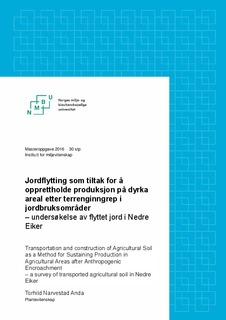| dc.contributor.advisor | Krogstad, Tore | |
| dc.contributor.advisor | Haraldsen, Trond Knapp | |
| dc.contributor.author | Anda, Torhild Narvestad | |
| dc.coverage.spatial | Norway, Buskerud | nb_NO |
| dc.date.accessioned | 2016-08-11T11:02:48Z | |
| dc.date.available | 2016-08-11T11:02:48Z | |
| dc.date.issued | 2016-08-11 | |
| dc.identifier.uri | http://hdl.handle.net/11250/2398784 | |
| dc.description.abstract | Jordflytting blir i dag sett på som en mulig løsning på den stadige konflikten mellom jordvern og utbygging i sentrale strøk. Det er imidlertid lite kunnskap og få gode eksempler å vise til, og metoden fremstilles som usikker. Låg beskrev i 1981 et jordflyttingsprosjekt i Nedre Eiker kommune der overskuddsmasser fra arbeidet med en veiskjæring ble gjenoppbygget som et jordsmonn beregnet for jordbruksdrift på to lokaliteter. Gjennom en undersøkelse av disse to arealene, Elvesletta og Steinberghaugen, er formålet med oppgaven å dokumentere et eksempel på hvordan jordflytting har fungert i praksis. I løpet av 2015 ble det gjennomført avlingsregistreringer og jordundersøkelser, blant annet gjennom beskrivelse av jordprofiler, både på flytta jord og opprinnelig jordsmonn i samme område.
Det var i undergrunnsjorda at det ble funnet størst forskjeller mellom opprinnelig og flytta jord. Prøver av toppjorda (øvre 20 cm) samt analyser av korn viste få forskjeller på begge områder. I motsetning til i opprinnelig jord, ble det ikke funnet noe form for horisontal lagdeling under Ap-sjiktene i flytta jord. På Elvesletta ble det også funnet stor variasjon i oppbygging innad på den flytta jorda. Årlig vannmetning av arealet som følge av flom, setter bruksbegrensninger både på opprinnelig og flytta jord på Elvesletta. Bruk av siltige masser har gjort den flytta jorda særlig pakkingsutsatt. Oppbyggingen av jordsmonnet bidrar til dårlig drenering og gir reduserte muligheter for rotutvikling. Basert på undersøkelsene kan man likevel hevde at det er ”normal” produksjon på den flytta jorda (495 kg(TS)/daa hvete) og at Elvesletta er høyst drivverdig som kornareal.
Den opprinnelige jorda på Steinberghaugen var noe mer tørkesterk og hadde noe bedre drenering enn den flytta jorda. Det var også signifikant høyere avling på den opprinnelige jorda. Likevel var avlingene både på opprinnelig og flytta jord, henholdsvis 798 og 728 kg (TS)/daa, betydelig høyere enn gjennomsnittlig avling for bygg i Buskerud; 337 kg/daa (2004 - 2014). På bakgrunn av undersøkelsene er det liten tvil om at arealet på Steinberghaugen er drivverdig som kornareal, og man kan hevde at det er høy produksjon. | nb_NO |
| dc.description.abstract | The expansion of urban areas, with the associated building of infrastructure, has often led to loss of agricultural land in Norway. It has been proposed that by transporting soil, and reconstruct it as agricultural soil at new locations, one could limit the loss of high quality soil in these areas. Meanwhile, questions are raised regarding the lack of good reference examples and knowledge about the method. In Nedre Eiker the method was used as part of a road cut construction work in 1981, and resulted in two new areas with arable land. This thesis aims to conduct a survey to follow up these two land areas, by studying soil profiles as well as analysing soil samples and yields. For comparison, the same investigations were carried out for natural soils in adjoining areas.
The main difference between the natural soil and the transported and constructed soil and was the construction of the subsoil. While natural soils were characterized by a horizontal stratification within the profile, this was not the case in the areas with constructed soil. In these areas, the soil in the C-horizon had a lack of stratification and an apparently random alignment. By describing two profiles of constructed soils at Elvesletta, a great variation within the constructed area was also discovered. Fluctuations in ground water level, caused by the flooding of the nearby river, at this location usually lead to a fully saturated soil every spring. The silty soil types cause high moisture content, and combined with a poor drainage, the risk of soil compaction is high. In spite of this the yield levels at Elvesletta were normal.
At Steinberghaugen the constructed subsoil had slightly lower water holding capacity as well as somewhat poorer drainage, as compared to the natural soil. The yield was also significantly lower. Still, the yields are considerable larger than the average yields in Buskerud county from previous years (2004 – 2014), both for constructed and natural soils at Steinberghaugen. | nb_NO |
| dc.language.iso | nob | nb_NO |
| dc.publisher | Norwegian University of Life Sciences, Ås | |
| dc.subject | Jordflytting | nb_NO |
| dc.subject | Jord | nb_NO |
| dc.subject | Jordsmonnoppbygging | nb_NO |
| dc.title | Jordflytting som tiltak for å opprettholde produksjon på dyrka areal etter terrenginngrep i jordbruksområder : undersøkelse av flyttet jord i Nedre Eiker | nb_NO |
| dc.title.alternative | Transportation of Agricultural Soil as a method for Sustaining Production in Agricultural Areas after Anthropogenic Encroachment - a Survey of transported agricultural soil in Nedre Eiker | nb_NO |
| dc.type | Master thesis | nb_NO |
| dc.subject.nsi | VDP::Mathematics and natural science: 400 | nb_NO |
| dc.subject.nsi | VDP::Agriculture and fishery disciplines: 900 | nb_NO |
| dc.source.pagenumber | 62 | nb_NO |
| dc.description.localcode | M-MINA | nb_NO |
